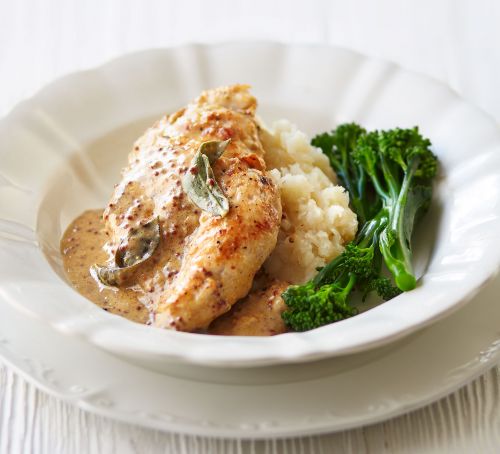"Cauliflower is an extremely healthy vegetable that’s a significant source of nutrients. It also contains unique plant compounds that may reduce the risk of several diseases, including heart disease and cancer. Additionally, it’s weight loss friendly and incredibly easy to add to your diet.
Here are 8 science-based health benefits of cauliflower.
1. Contains Many Nutrients
The nutrition profile of cauliflower is quite impressive.
Cauliflower is very low in calories yet high in vitamins. In fact, cauliflower contains some of almost every vitamin and mineral that you need.
Here is an overview of the nutrients found in 1 cup, or 128 grams, of raw cauliflower:
Calories: 25
Fiber: 3 grams
Vitamin C: 77% of the RDI
Vitamin K: 20% of the RDI
Vitamin B6: 11% of the RDI
Folate: 14% of the RDI
Pantothenic acid: 7% of the RDI
Potassium: 9% of the RDI
Manganese: 8% of the RDI
Magnesium: 4% of the RDI
Phosphorus: 4% of the RDI
Summary: Cauliflower is an excellent source of vitamins and minerals, containing some of almost every vitamin and mineral that you need.
2. High in Fiber
Cauliflower is quite high in fiber, which is beneficial for overall health. There are 3 grams of fiber in one cup of cauliflower, which is 10% of your daily needs.
Fiber is important because it feeds the healthy bacteria in your gut that help reduce inflammation and promote digestive health.
Consuming enough fiber may help prevent digestive conditions like constipation, diverticulitis and inflammatory bowel disease (IBD).
Moreover, studies show that a diet high in fiber-rich vegetables like cauliflower is linked with a lower risk of several illnesses, including heart disease, cancer and diabetes.
Fiber may also play a role in obesity prevention, due to its ability to promote fullness and reduce overall calorie intake.
Summary: Cauliflower contains a high amount of fiber, which is important for digestive health and may reduce the risk of several chronic diseases.
3. Good Source of Antioxidants
Cauliflower is a great source of antioxidants, which protect your cells from harmful free radicals and inflammation. Similar to other cruciferous vegetables, cauliflower is particularly high in glucosinolates and isothiocyanates, two groups of antioxidants that have been shown to slow the growth of cancer cells.
...cauliflower contains high amounts of vitamin C, which acts as an antioxidant. It is well-known for its anti-inflammatory effects that may boost immune health and reduce the risk of heart disease and cancer.
Summary: Cauliflower provides a significant amount of antioxidants, which are beneficial for reducing inflammation and protecting against several chronic diseases.
4. May Aid in Weight Loss

Cauliflower has several properties that may help with weight loss.
First, it is low in calories with only 25 calories per cup, so you can eat a lot of it without gaining weight. It can also serve as a low-calorie substitute for high-calorie foods, such as rice and flour.
As a good source of fiber, cauliflower slows digestion and promotes feelings of fullness. This may automatically reduce the number of calories you eat throughout the day, an important factor in weight control.
High water content is another weight loss friendly aspect of cauliflower. In fact, 92% of its weight is made up of water. Consuming lots of water-dense, low-calorie foods is associated with weight loss.
Summary: Cauliflower is low in calories but high in fiber and water — all properties that may assist in weight loss.
5. High in Choline
Cauliflower is high in choline, an essential nutrient that many people are deficient in. Choline has several important functions in the body. To begin with, it plays a major role in maintaining the integrity of cell membranes, synthesizing DNA and supporting metabolism. Choline is also involved in brain development and the production of neurotransmitters that are necessary for a healthy nervous system. What’s more, it helps prevent cholesterol from accumulating in the liver.
Those who don’t consume enough choline may have a higher risk of liver and heart disease, in addition to neurological disorders like dementia and Alzheimer’s.
Not many foods contain choline. Cauliflower, along with broccoli, is one of the best plant-based sources of the nutrient.
Summary: Cauliflower is a good source of choline, a nutrient many people are lacking. It is involved in many processes in the body and works to prevent several diseases.
6. Rich in Sulforaphane
According to some studies, sulforaphane may also have the potential to stop cancer growth by destroying cells that are already damaged.
Sulforaphane appears to be most protective against colon and prostate cancer but has also been studied for its effects on many other cancers, such as breast, leukaemia, pancreatic and melanoma.
Research shows that sulforaphane may also help reduce high blood pressure and keep arteries healthy — both major factors in preventing heart disease.
While more research is necessary to determine the extent of sulforaphane’s effects in humans, its potential health benefits are promising.
Summary: Cauliflower is rich is sulforaphane, a plant compound with many beneficial effects, such as reduced risk of cancer, heart disease and diabetes.
7. Low-Carb Alternative to Grains and Legumes
Cauliflower is incredibly versatile and can be used to replace grains and legumes in your diet. Not only is this a fantastic way to increase your veggie intake, but it is also especially helpful for those who follow low carb diets. This is because cauliflower is significantly lower in carbs than grains and legumes.
For example, a cup of cauliflower contains 5 grams of carbs. At the same time, a cup of rice contains 45 grams of carbs — nine times the amount of cauliflower.
Here are some examples of recipes that can be made with cauliflower instead of grains and legumes:
Cauliflower rice: Replace white or brown rice with cauliflower that has been grated and then cooked.
Cauliflower pizza crust: By pulsing cauliflower in a food processor and then making it into a dough, you can make a delicious pizza.
Cauliflower hummus: Chickpeas can be replaced with cauliflower in hummus recipes.
Cauliflower mash: Instead of making mashed potatoes, try a low-carb cauliflower mash.
Cauliflower tortillas: Combine pulsed cauliflower with eggs to make low-carb tortillas that can be used for wraps, taco shells or burritos.
Cauliflower mac and cheese: Cooked cauliflower can be combined with milk, cheese and spices to make mac and cheese.
Summary: Cauliflower can replace grains and legumes in many recipes, which is a great way to eat more veggies or follow a low-carb diet.
8. Easy to Add to Your Diet
Not only is cauliflower versatile, but it is also very easy to add to your diet. To begin with, you can consume it raw, which requires very little preparation. You can enjoy raw cauliflower florets as a snack dipped in hummus or another healthy vegetable dip.
Cauliflower can also be cooked in a variety of ways, such as steaming, roasting or sautéing. It makes an excellent side dish or can be combined with dishes like soups, salads, stir-fries and casseroles.
Summary: There are many ways to add cauliflower to your diet. It can be consumed cooked or raw and makes a fantastic addition to just about any dish.
The Bottom Line
Cauliflower provides some powerful health benefits.
It is a great source of nutrients, including a few that many people need more of. Plus, cauliflower contains unique antioxidants that may reduce inflammation and protect against several diseases, such as cancer and heart disease.
What’s more, cauliflower is easy to add your diet. It’s tasty, easy to prepare and can replace high-carb foods in several recipes."
The above words have been taken from Authority Nutrition site.
To see the full article with all information / research links use this link here
Parmesan Crusted Cauliflower - see more here
We bring a variety of articles, studies etc. plus recent news/views and recipe ideas to this blog, we hope something for everyone to read and enjoy.
Please note, not all may be suitable for you.
If you may have any food allergies, or underlying health issues these must always be taken into account. If you are a diabetic and not sure how certain foods may affect your blood sugars, test is best, i.e. use your meter.
All the best Jan




























